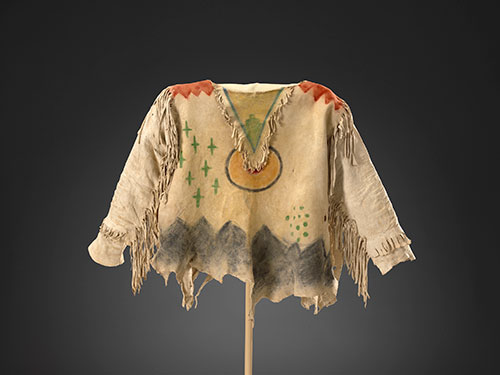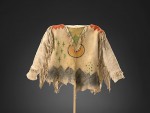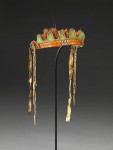The Virginia Museum of Fine Arts recently acquired 21 new artworks for its Native American collection. This acquisition includes objects from the Plains, Puebloan Southwest, Arctic North, and Northwest Coast. Highlights of the new collection include a Pueblo/Apache shirt and a Northern Great Lakes/Eastern Plains headdress. Both of these works and 19 additional Native American objects are part of a long-term gift/purchase agreement with Robert and Nancy Nooter. The Native American and Pre-Columbian collections are being installed in the Evans Court, and will be on view with the new acquisitions this Friday, June 26.
The new Evans Court home will create an opportunity for VMFA to expand the footprint of its acclaimed collection of American art while preserving the importance of its popular Native American and Pre-Columbian gallery, previously located adjacent to the American galleries. The Evans Court is a popular destination for visitors that also showcases special exhibition galleries—displaying Japanese Tattoo: Perseverance, Art, and Tradition through September 27—as well as the museum’s African art galleries.
Pueblo/Apache Hide Shirt
This unique hide shirt is likely from the Taos Pueblo. Hide shirts, generally thought of as a Plains garment, were common to some Southwestern groups as well. In most instances, these hide shirts were constructed in a similar manner, with long triangular bibs on each side and long leather fringe along all the edges with additional fringe on the sleeves. The snug fitting sleeves are a distinctive aspect of the Southwestern style shirt; they are usually left undecorated but occasionally may be painted yellow, green, red, or blue. However, the painting is the most distinguishing feature of this remarkable garment. Unlike most other Pueblo or Apache hide shirts, this example is painted with representational designs. Aesthetically, it is a strong object that will add much to what we know of ceremonial pieces from this region.
Headdress
This unusual headdress is similar in form to the crown-like headdresses of the Otoe people, one of the late 18th century Northern Great Lakes tribes. A crenulated leather headband coated with green paint forms the foundation of the headdress. Red-dyed horsehair, which was cropped off either during construction or at a later date, is attached around the interior of the headband. A double row of dyed bird quills decorate the base of the headdress, and hide tassels are attached to each of the ends. This form serves as a prototype of sorts for the later, more familiar feathered headdresses of the Plains people. The headdress is an extraordinary piece, as very few comparable examples exist.
Additional Gifts of the Robert and Nancy Nooter Collection:
- Kiapkwa (Ancestral Zuni), Canteen, ca. 1850, native clay and pigments, 9 x 9½ x 7″
- Zuni, Kachina, wood, feathers, clothe, bells, turquoise, 11-3/16 x 4⅞ x 4¾”
- Zuni, Kachina, wood, feathers, clothe, leather, 10⅜ x 4⅜ x 4⅛”
- Zuni, Kachina, wood, cloth, 17⅝ x 2½ x 5¾”
- Sioux, Dance Stick, wood, leather, 41⅝ x 7⅞ x 1¼”
- Arikara, Drum w/Buffalo Image, leather, wood, 2⅝ x 10⅞ ” dia.
- Socorro, Effigy Canteen, ceramic, pigment, 6 x 4 x 5”
- Tularosa, Olla, ceramic, pigment, 12 x 16”
About VMFA Acquisitions
These works of art were approved by VMFA’s Board of Trustees on March 19, 2015. All art is purchased with private funds from dedicated endowments. VMFA is a state agency and a public/private partnership. After trustee approval, the art becomes the property of the Commonwealth of Virginia to protect, preserve, and interpret.
About the Virginia Museum of Fine Arts
VMFA’s permanent collection encompasses more than 33,000 works of art spanning 5,000 years of world history. Its collections of Art Nouveau and Art Deco, English silver, Fabergé, and the art of South Asia are among the finest in the nation. With acclaimed holdings in American, British Sporting, Impressionist and Post-Impressionist, and Modern and Contemporary art – and additional strengths in African, Ancient, East Asian, and European – VMFA ranks as one of the top comprehensive art museums in the United States. Programs include educational activities and studio classes for all ages, plus lively after-hours events. VMFA’s Statewide Partnership program includes traveling exhibitions, artist and teacher workshops, and lectures across the Commonwealth. VMFA, a certified Virginia Green attraction, is open 365 days a year and general admission is always free. For additional information, telephone 804-340-1400 or visit www.vmfa.museum.
# # #


